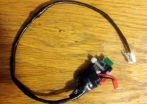(Press-News.org) PHILADELPHIA — Directed assembly is a growing field of research in nanotechnology in which scientists and engineers aim to manufacture structures on the smallest scales without having to individually manipulate each component. Rather, they set out precisely defined starting conditions and let the physics and chemistry that govern those components do the rest.
An interdisciplinary team of researchers from the University of Pennsylvania has shown a new way to direct the assembly of liquid crystals, generating small features that spontaneously arrange in arrays based on much larger templates.
The study was led by Shu Yang, associate professor in the School of Engineering and Applied Science's departments of Materials Science and Engineering and Chemical and Biomolecular Engineering; Kathleen Stebe, Engineering's vice dean for research and professor in Chemical and Biomolecular Engineering; and Randall Kamien, professor in the School of Arts and Sciences' Department of Physics and Astronomy. Apiradee Honglawan of Yang's lab, Daniel Beller of Kamien's group and Marcello Cavallaro Jr. of Stebe's lab also contributed to the research.
They came together through Penn's Materials Research Science and Engineering Center, which recently received a $21.7 million National Science Foundation grant to support this kind of interdisciplinary research. Stebe and Kamien are leaders of the Center's sub-group focused on elasticity in soft materials and knew they had the expertise on hand to do groundbreaking work with liquid crystals.
Their work was published in the Proceedings of the National Academy of Sciences.
Crystals are materials that have molecules arrayed in regular three-dimensional patterns; liquid crystals contain some, but not all, of these patterns, and their molecules can flow around one another and change the direction they face. This behavior allows defects, places on the surface where the molecular orientation of the liquid crystals is disrupted.
Despite their name, such defects are highly desirable. If the location of the defects can be controlled, the change in pattern or orientation can be put to use. In a liquid crystal display, for example, the crystals' orientation in different regions determines which parts of the screen are illuminated.
"Liquid crystals naturally produce a pattern of close-packed defects on their surfaces," Yang said, "but it turns out that this pattern is often not that interesting for device applications. We want to arbitrarily manipulate that pattern on demand."
Electrical fields are often used to change the crystals' orientation, as in the case with liquid crystal displays, but the Penn research team was interested in manipulating defects by using a physical template. Employing a class of liquid crystals that forms stacks of layers spaced in nanometers — known as "smectic" liquid crystals — the researchers set out to show that, by altering the geometry of the molecules on the bottommost layer, they could produce changes in the patterns of defects on the topmost.
"The molecules can feel the geometry of the template, which creates a sort of elastic cue," Stebe said. "That cue is transmitted layer by layer, and the whole system responds."
The researchers' template was a series of microscopic posts arrayed like a bed of nails. By altering the size, shape, symmetry and spacing of these posts, as well as the thickness of the liquid crystal film, the researchers discovered they could make subtle changes in the patterns of the defects.
For example, a smectic liquid crystal that would naturally form a hexagonal array of dimple-like defects on its surface could be templated to form a square pattern or to have dimples that were more closely or loosely packed.
Critically, these induced defect patterns weren't one-to-one reproductions of the pattern of posts on the template layer. The researchers were able to generate more complex relationships, such as getting four defects to sit atop each circular post or defects that formed over the points of a triangular post. They were also able to deduce the rules that govern these relationships and predict what defect patterns a given set of post parameters would produce.
"The first layer's molecules tend to be pinned to the edges of the posts," Kamien said, "so changing a post's size and shape will change how many defects can sit on its edges at the same time."
The size discrepancy between the posts and individual molecules of the liquid crystal is also a key feature for using this class of liquid crystal in directed assembly. The posts are each a few microns wide and tall, still microscopically small, but large enough to be easily and economically made to specification. This is much more attractive than trying to directly control the size and arrangement of the liquid crystals' defects.
"The liquid crystal layers are very thin, so the defects are on the order of several nanometers across" Kamien said. "Those defects would normally be very hard to control, especially compared to the posts, which are more like a few thousand nanometers across."
Beyond sensors and displays, these defects can be used in nanomanufacturing.
"If you make defects like dimples, you could put ink in them and use them like a stamp," Kamien said. "Or you could make the inverse of the dimples and make points, which could be used as localized surface plasmon resonance hot spots for chemical and biological sensing or as a topographic protrusion for creating a superhydrophobic surface."
And because the layers of liquid crystals transmit elastic energy, they can also be used to do mechanical work. This means that the top layer could be used as a template to assemble even larger molecules.
"You could put nanoparticles, quantum dots or carbon nanotubes in the liquid crystal layers and they would be expelled into to the defects," Yang said.
A template consisting of circular posts could even be dynamically altered with heat and an electric field, for example, making the posts in a certain region elliptical. This microscopic geometric cue would travel up the layers of liquid crystal and produce micrometer-scale changes on the surface.
By establishing the mathematical relationships between the post parameters and the surface-layer defects, the researchers are laying the foundation of a directed assembly technique that can be used with any smectic liquid crystal.
"We are providing a very crude cue and getting exquisite molecular level organization," Stebe said. "Any liquid crystal that makes layers can now be used to make rather beautiful control over textures on the surface.
INFORMATION:
The research was supported by the National Science Foundation.
Penn researchers show new level of control over liquid crystals
2013-01-08
ELSE PRESS RELEASES FROM THIS DATE:
Computer scientists find vulnerabilities in Cisco VoIP phones
2013-01-08
New York, NY—January 7, 2013—Columbia Engineering's Computer Science PhD candidate Ang Cui and Computer Science Professor Salvatore Stolfo have found serious vulnerabilities in Cisco VoIP (voice over internet protocol) telephones, devices used around the world by a broad range of networked organizations from governments to banks to major corporations, and beyond. In particular, they have discovered troubling security breaches with Cisco's VoIP phone technology. At a recent conference on the security of connected devices, Cui demonstrated how they can easily insert malicious ...
Black and Hispanic patients less likely to complete substance abuse treatment, Penn study shows
2013-01-08
PHILADELPHIA – Roughly half of all black and Hispanic patients who enter publicly funded alcohol treatment programs do not complete treatment, compared to 62 percent of white patients, according to a new study from a team of researchers including the Perelman School of Medicine at the University of Pennsylvania. Comparable disparities were also identified for drug treatment program completion rates. The study, published in the latest issue of Health Affairs, shows that completion disparities among racial groups are likely related to differences in socioeconomic status and, ...
Obese moms risk having babies with low vitamin D
2013-01-08
CHICAGO --- Women who are obese at the start of their pregnancy may be passing on insufficient levels of vitamin D to their babies, according to a new Northwestern Medicine® study.
The study found that babies born to lean mothers had a third higher amount of vitamin D compared to babies born to obese moms.
Vitamin D is fat-soluble, and previous studies have found that people who are obese tend to have lower levels of the vitamin in their blood. In this study, both obese and lean mothers had very similar levels of vitamin D at the end of their pregnancies, yet obese ...
Southern Medical Journal presents special issue on disaster preparedness
2013-01-08
Philadelphia, Pa. (January 7, 2013) – Surveys suggest that while most US physicians are willing to play a role in responding to natural and manmade disasters, most do not feel adequately prepared to fulfill that role. Toward helping physicians and health care systems understand and fulfill their obligation to provide medical care in disasters, the January Southern Medical Journal is a special issue on disaster medicine and physician preparedness. The official journal of the Southern Medical Association, the SMJ is published by Lippincott Williams & Wilkins, a part of Wolters ...
Study looks at how states decide which child receives early intervention for developmental problems
2013-01-08
AURORA, Colo. (Jan. 7, 2013) A new study out by researchers at the University of Colorado School of Medicine, found large differences in the criteria that states use to determine eligibility for Part C early intervention services for infants and toddlers who have developmental delays. A developmental delay is any significant lag in a child's development as compared with typical child development.
Current eligibility criteria for Part C services vary from state to state. With their colleagues, Steven Rosenberg, PhD, associate professor, University of Colorado Department ...
At least 1 in 6 stars has an Earth-sized planet
2013-01-08
The quest for a twin Earth is heating up. Using NASA's Kepler spacecraft, astronomers are beginning to find Earth-sized planets orbiting distant stars. A new analysis of Kepler data shows that about 17 percent of stars have an Earth-sized planet in an orbit closer than Mercury. Since the Milky Way has about 100 billion stars, there are at least 17 billion Earth-sized worlds out there.
Francois Fressin, of the Harvard-Smithsonian Center for Astrophysics (CfA), presented the analysis today in a press conference at a meeting of the American Astronomical Society in Long Beach, ...
Exocomets may be as common as exoplanets
2013-01-08
Comets trailing wispy tails across the night sky are a beautiful byproduct of our solar system's formation, icy leftovers from 4.6 billion years ago when the planets coalesced from rocky rubble.
The discovery by astronomers at the University of California, Berkeley, and Clarion University in Pennsylvania of six likely comets around distant stars suggests that comets – dubbed "exocomets" – are just as common in other stellar systems with planets.
Though only one of the 10 stars now thought to harbor comets is known to harbor planets, the fact that all these stars have ...
People with diabetes in Ontario getting fewer government-funded eye exams, new study finds
2013-01-08
TORONTO, Jan. 7, 2013—A new study has found that adults with diabetes in Ontario are getting significantly fewer government-funded eye exams than they were a decade ago, a key component of high-quality diabetes care essential to preventing diabetes-related eye complications.
The decrease is an unintended consequence of the provincial government's decision in 2004 to delist routine eye exams from the Ontario Health Insurance Plan for healthy adults under age 65, said lead researcher Dr. Tara Kiran.
Routine eye exams continue to be funded for adults with diabetes and other ...
Electronic health records with technical assistance can improve patient care in New York City
2013-01-08
NEW YORK (Jan. 7, 2013) -- The relationship between a physician practice's adoption of electronic health records (EHR) and quality improvements in patient care remains unclear. However, a new study published in the January issue of Health Affairs by Weill Cornell Medical College and the Primary Care Information Project (PCIP) of the New York City Health Department shows evidence that EHR implementation can improve patient care in small physician practices in New York City when combined with sustained high-intensity technical assistance.
To evaluate the effects EHRs have ...
Detecting dusty clouds and stars in our galaxy in a new way
2013-01-08
The center of our Milky Way galaxy is a wondrous place full of huge star clusters, dust clouds, magnetic filaments and a supermassive black hole. But it can be a confusing place, too, posing challenges to astronomers trying to image these exotic features and learn more about where they are located in the galaxy.
Northwestern University's Farhad Zadeh has discovered a new tool for detecting dusty clouds and stars: simply take a picture using radio waves. He is the first to identify what he calls radio dark clouds and stars. Stars in the early and late phases of their ...



